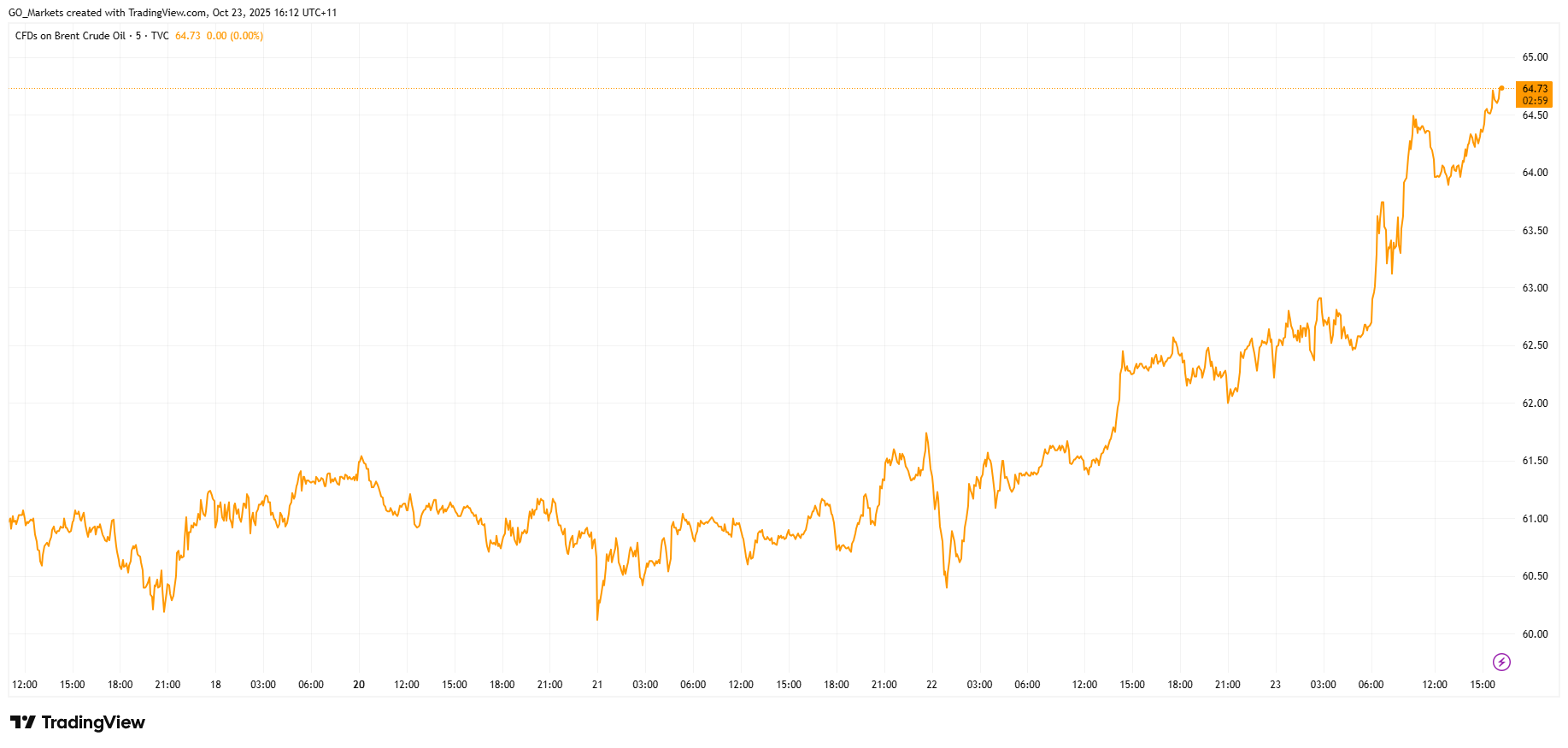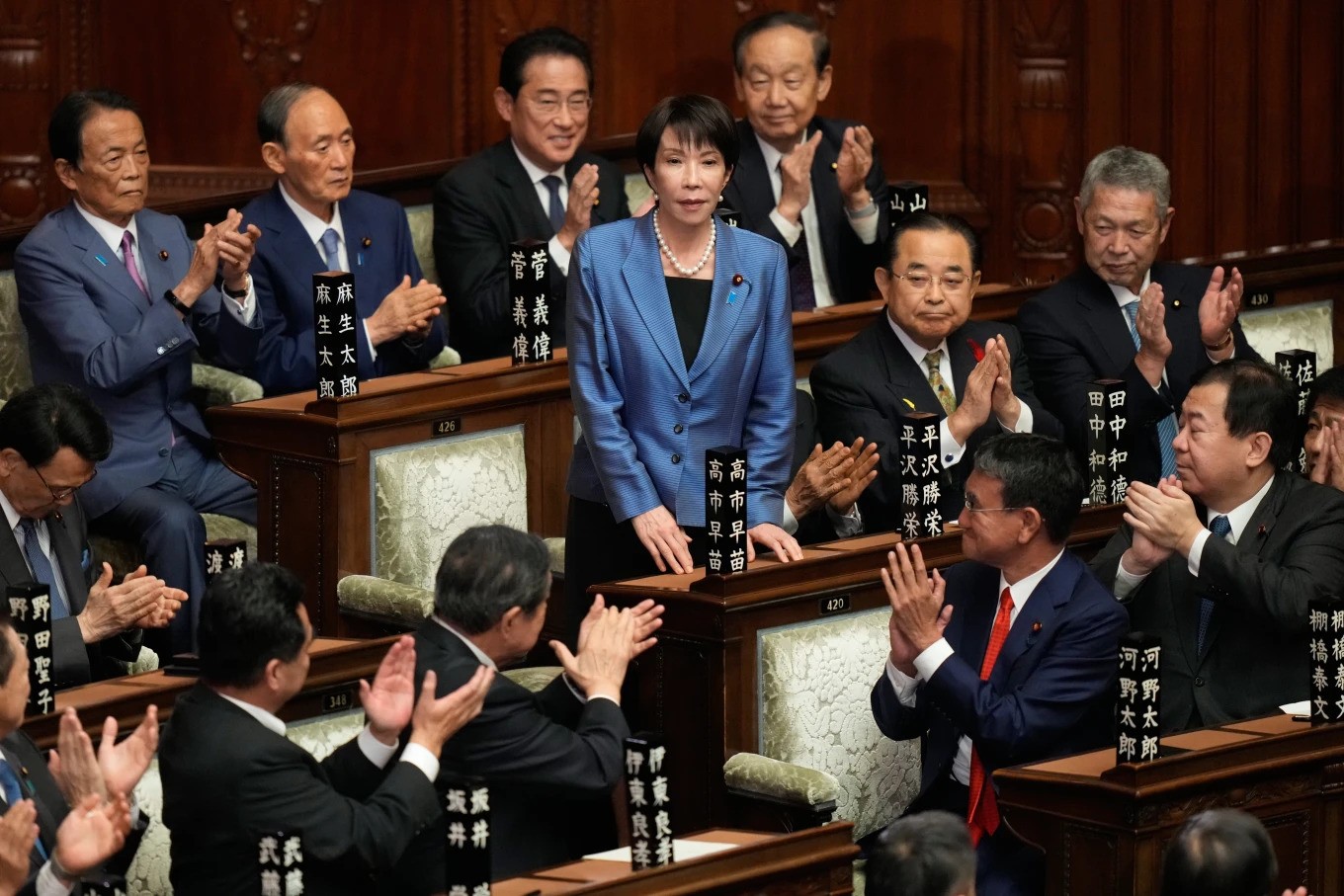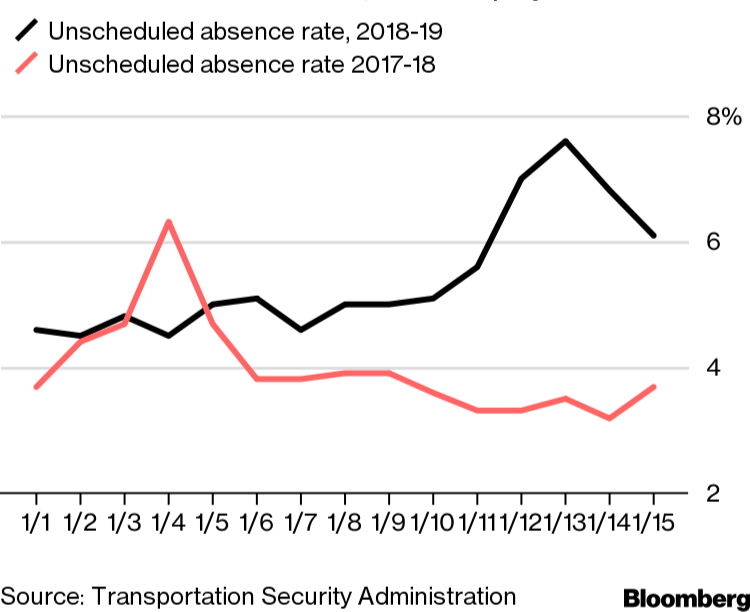市場新聞與洞察
透過專家洞察、新聞與技術分析,助你領先市場,制定交易決策。

New U.S. Sanctions on Russia as Putin Conducts Nuclear Tests
The U.S. has imposed new sanctions on Russia's two largest oil companies, Rosneft and Lukoil, after planned peace talks between Trump and Putin collapsed on Wednesday.
Oil prices spiked 3% after the announcement, with Brent crude hitting $64 per barrel.

The targeted companies are among the world's largest energy exporters, collectively shipping about three million barrels of oil daily and accounting for nearly half of Russian production.
The sanctions build on recent European measures, as the UK targeted the same companies last week and the EU approved its own sanctions package on Wednesday.
In a show of force coinciding with the new sanctions, Putin supervised strategic nuclear exercises on Wednesday involving intercontinental ballistic missile launches from land and submarine platforms.
While the Kremlin emphasised these were routine drills, the highly coincidental timing is notable.
For markets, the key question now is whether secondary sanctions will follow, and if Trump’s enforcement remains strict. Traders will watch closely for any TACO signals that see Trump ease pressure in an attempt to restart negotiations.
Historic PM Wasting No Time on Celebrations
Sanae Takaichi made history this week as Japan's first female Prime Minister. The 64-year-old conservative leader, dubbed the "Iron Lady,” is already rolling out an aggressive policy agenda that could reshape Japan's economic and geopolitical position.
Her first major move is an economic stimulus package expected to exceed US $92 billion. The package includes abolishing the provisional gasoline tax and raising the tax-free income threshold from ¥1.03 million ($6,800), moves designed to put more money in consumers' pockets and battle inflation.

Her next move will come when Trump arrives in Tokyo next week, as the Japanese government is finalising a purchase package including Ford F-150 pickup trucks, US soybeans, and liquefied natural gas as sweeteners for trade talks.
Takaichi has campaigned on being a champion for expansionary fiscal policy, monetary easing, and heavy government investment in strategic sectors, including AI, semiconductors, biotechnology, and defence.
Critical Workers to Miss First Paycheck Due to Shutdown
The U.S. government shutdown is on the verge of creating a crisis for aviation safety, with 60,000 workers set to miss their first full paycheck this week.
These essential workers, who earn an average of $40,000 annually, already saw shortened paychecks last week. By Thursday, many will receive pay stubs showing zero compensation for the coming period, forcing impossible choices between basic necessities and reporting to work.
During the last extended shutdown, TSA sick-call rates tripled by Day 31, causing major delays at checkpoints and reduced air traffic in major hubs like New York — disruptions which are directly attributed to pressuring the end of the previous shutdown.

The National Air Traffic Controllers Association warns that similar pressures are building, with many workers soon to be facing a decision between attending their shift or putting food on the table.


Trading terms glossary A - B - C - D - E - F - G - H - I - J - K - L - M - N - O - P - Q - R - S - T - U - V - W - X - Y - Z - L Leverage Leverage lets traders multiply their investment without the need to invest additional capital. e.g. If a broker offers 20:1 leverage, with an investment of $1,000 a trader could open a position of $20,000. It is important to note that leverage amplifies both profits and losses, it is critical this be factored in when determining risk and potential losses.
Liabilities Liabilities are a companies debts and financial obligations represented on its balance sheet. This is critical in determining the value of a company when potentially investing and liabilities offset company assets. Limit orders Limit orders execute a trade at a particular level that is more favorable than the marketing price at that time.
Limit down / limit up Limit down is the maximum amount a commodity future may decrease, while limit up is the maximum amount one may increase, in a single trading session. Liquidity (Market liquidity) Liquidity is used in finance to describe how easily an asset can be traded. When there is a high volume of active traders of an asset, there is high liquidity, and it is easier to find buyers and sellers for that asset.
Low liquidity markets can be difficult to trade, as there may not be many buyers and sellers willing to trade at an agreeable price. London Interbank Offered Rate (LIBOR) LIBOR is a daily reference rate based on the interest rates at which banks borrowed unsecured funds from other banks in the London interbank market, however LIBOR is being gradually discontinued. USD-LIBOR has been replaced by SOFR (Secured Overnight Financing Rate) and GBP-LIBOR has been replaced by SONIA (Sterling overnight index average).
Long "Going long" refers to taking a position that makes profit if an asset’s market price rises. Also referred to as "taking a long position". Lot A lot is a standardised group of assets that is traded instead of a single asset.
In the futures markets, lots are referred to as "contract sizes".


Trading terms glossary A - B - C - D - E - F - G - H - I - J - K - L - M - N - O - P - Q - R - S - T - U - V - W - X - Y - Z - J


Trading terms glossary A - B - C - D - E - F - G - H - I - J - K - L - M - N - O - P - Q - R - S - T - U - V - W - X - Y - Z - I Iceberg order An Iceberg order divides large orders into smaller segments. They are often used by traders for the purpose of hiding the full order quantity in order to minimise market disruption. Ichimoku Cloud The Ichimoku Cloud is a technical analysis indicator that shows support and resistance levels, as well as momentum and trend direction.
Roughly translated from Japanese, 'Ichimoku Kinko Hyo' means ‘one look equilibrium chart,' meaning traders can receive an array of information with just one look. In the money In the money (ITM) is defined by an option’s state of ‘moneyness’. More specifically, it refers to when an option goes beyond its strike price, giving it an intrinsic value of more than $0.
Index An index is a measure of something. In trading, an index is a grouping of financial assets that are used to give a performance indicator of a particular sector. Indices trading Indices trading refers to traders' endeavors to make money on the price movements of indices.
Inflation Inflation is the increase in the cost of goods and services in an economy, or the decline in the purchasing power of money (devaluing of currency). Learn more about Inflation. Interest Interest is the charge levied against a party for borrowing money, which can be either a cost or a means of making profit for a trader.
In trading, it can also refer to the amount of ownership a stockholder has in a company. Interest rates The amount that a lender charges to a borrower for the loan of an asset. The rate is expressed as a percentage of the loan.
Intrinsic value Intrinsic value is a measure of the perceived value of an asset. This is not always the same as the current market price because assets can be over- or undervalued. Interbank/Interdealer Market A market only open to large financial institutions, to trade between them.
This market is not restricted to a physical location and it does not have a centralised exchange. Investment capital A trader’s investment capital is the financial resources they currently have available for trading. It could be in the form of money or other assets.
It can also refer to funds invested in a firm or company for the purpose of furthering its business objectives. Investor An investor is a person who devotes capital to an investment, with the hope of seeing a return. The main goal of any investor is to minimise risk and maximise return.
IPO IPO stands for initial public offering. This is the first sale of a stock by a company, when it goes public on a stock exchange. This can also be known as floating, flotation, or just ‘going public’.


Trading terms glossary A - B - C - D - E - F - G - H - I - J - K - L - M - N - O - P - Q - R - S - T - U - V - W - X - Y - Z - H Handle In trading, the term ‘handle’ has two meanings, depending on which market you are referring to. In most markets, handle is the the part of a price quote that exists to the left of the decimal point in the full quote. In forex, it refers to the part of the quote that you see in both the buy and sell price.
Hawks and doves The terms used by analysts and traders to classify the members of the Central Bank committee ahead of their votes and monetary policy is known as Hawks and doves. Learn more about Hawks and Doves Hedge/Hedging A hedge is an investment or trade designed to reduce your existing exposure to risk. The process of reducing risk via investments is termed as 'hedging'.
Heikin Ashi Heikin Ashi is a type of chart pattern used in technical analysis. Heikin Ashi charts are similar to candlestick charts, but the main difference is that a Heikin Ashi chart uses the daily price averages to show the median price movement of an asset. High frequency trading A form of advanced trading platform that processes a high numbers of trades very quickly using powerful computing technology is termed as High Frequency Trading (HFT).
It can be used to either find the best price for a single large order, or to find opportunities for profit in the market in real time.


Trading terms glossary A - B - C - D - E - F - G - H - I - J - K - L - M - N - O - P - Q - R - S - T - U - V - W - X - Y - Z - F Face Value Face value represents the amount that must be paid out at a bond or stock's maturity. It may also mean the dollar value of a security, set by the issuer. Fair value Fair value is the present value of a stock, once the stock's intrinsic value is considered.
This may cause debate, as fair value is based on a subjective understanding. Federal Reserve Referred to as the ‘Fed’ for short, the Federal Reserve is the central banking system in the United States. Fiat currency Money that is given legal tender status by a government and is not linked to the value of physical commodities like gold or silver.
Fibonacci retracement A Fibonacci retracement is a technical analysis tool that can help traders identify when to open and close a position, or when to apply stops and limits to their trades. It involves drawing trend lines on price charts between two points, usually the price highs and lows, in order to find possible areas of support and resistance. Fill Fill is the term used to refer to the completion of an order to trade a financial asset.
There is no guarantee that every trade will become filled. Financial instrument A financial instrument is a contract between two parties, which act as financial assets. These can be traded and settled.
Financial market A marketplace where the trading of securities occurs. The financial market provides an avenue for the purchase and sale of financial assets. Fixed costs Fixed costs are the expenses incurred by a company that are not impacted by the scale of production.
Fixed costs remain constant for a given period. Floating exchange rate A floating exchange rate is where the price of a currency is determined by supply and demand factors, relative to other currencies. Currencies with floating exchange rates can be traded without any restrictions, unlike fixed exchange rates.
FOMC The FOMC stands for the Federal Open Market Committee, which is a committee of the Federal Reserve System. The FOMC is in charge of decisions around interest rates and the US money supply. Forex Forex is a global marketplace for trading international currencies.
It is sometimes referred to as foreign exchange or FX. Forward contract A contract that has a defined date of expiry, which obliges the holder to buy or sell an asset by a specific date. The contract can vary and be customised between different instances.
Fundamental analysis Fundamental analysis is a method of evaluating the intrinsic value of an asset and analysing the factors that could influence its price in the future. This form of analysis is based on external events and influences, as well as financial statements and industry trends. Learn more about exit systems for a fundamental approach Futures contract A futures contract is an agreement between to buy or sell an asset at a defined price on a specified date in the future.
They are also sometimes referred to simply as ‘futures.'


Trading terms glossary A - B - C - D - E - F - G - H - I - J - K - L - M - N - O - P - Q - R - S - T - U - V - W - X - Y - Z - E Earnings per share Earnings per share (EPS) is the net profit of a company, divided by the number of outstanding shares. A tool commonly used to measure a company's profitability. EBITDA EBITDA (earnings before interest, taxes, depreciation, and amortization) is a way of evaluating a company’s performance.
An alternative measure to net income. ECB ECB stands for the European Central Bank, which is the central bank for the eurozone. Equity Equity can have several different meanings in the context of trading, however it usually refers to the ownership of an asset without any debt.
Equity options Equity options are contracts affording the owner the right, not the obligation, to trade to buy or sell shares of the underlying security at a specified price before the expiration date. ETF ETF stands for Exchange Traded Fund, which is a type of fund that is traded on a stock exchange. Learn more about ETF's ETP ETP stands for Exchange Traded Products, which are types of financial products that are publicly traded on a stock exchange.
Eurobond A eurobond is a debt instrument denominated in a currency other than the home currency (the market or country where it was issued). Sometimes referred to as external bonds. Eurodollar Bonds A type of eurobond, eurodollar bonds are denominated by the US dollar, but are sold outside of the US.
Can be sold worldwide. Exotics Exotics refer to c urrencies that are less actively traded. Exchange An open marketplace where financial instruments are traded.
An exchange can also be described as ‘the market.’ Execution The completion of a buy or sell order from a trader, actioned by a broker. Expiry date The day when a trading position automatically closes. Expiry (of a futures contract) The expiry date of a futures contract is the last day you can trade that contract.
Exposure Exposure can mean a variety of things in trading. It can either be the amount of money invested in a certain asset, or the total market value of an investor's open trades. Or it can refer to the total amount of possible risk at any given time.

